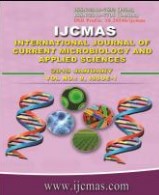


 National Academy of Agricultural Sciences (NAAS)
National Academy of Agricultural Sciences (NAAS)

|
PRINT ISSN : 2319-7692
Online ISSN : 2319-7706 Issues : 12 per year Publisher : Excellent Publishers Email : editorijcmas@gmail.com / submit@ijcmas.com Editor-in-chief: Dr.M.Prakash Index Copernicus ICV 2018: 95.39 NAAS RATING 2020: 5.38 |
Field experiments were conducted during 2015-16 and 2016-17 to study the effect of irrigation and N levels on nutrient uptake, water use efficiency and productivity of onion (Allium cepa L.) in Himachal Pradesh. Twelve treatment combinations comprising four irrigation level i.e. 4 cm irrigation at IW/CPE ratio 1.2 (I1), 1.0 (I2), 0.8 (I3), 0.6 (I4) and three N levels i.e. 75 (N1), 100 (N2) and 125 per cent (N3) of recommended dose of N, were replicated thrice in a Randomized Block Design. Nutrient uptake and bulb yield were at par under I1 and I2 levels and both these levels exhibited higher WUE, (115.1 and 104.9 kg ha-1mm-1) was recorded under I1 followed by I2 (109.7 and 104.6 kg ha1mm-1) with (35.42 and 39.14 cm) and (34.45 and 37.29 cm) of total water requirement during both the years of study, hence I2 was considered as efficient irrigation level. Among N levels, N3 was found to be optimum as it recorded significantly higher productivity of onion crop over N2 and N1 levels. Pooled analysis of the data showed that the combinations of I1N3 and I2N3 gave significantly higher bulb yield (467.0 q ha-1 and 435.5 q ha-1) and were noted to be 53.7 and 43.3 per cent higher over I4N1. The study led to a conclusion that the combination of irrigation level I2 (4 cm irrigation at 1.0 IW/CPE) with N3 level (125% of RD of N) (I2N3) could be the best for maximising yield of onion with efficient use of scarce irrigation water in Himachal Pradesh.
 |
 |
 |
 |
 |